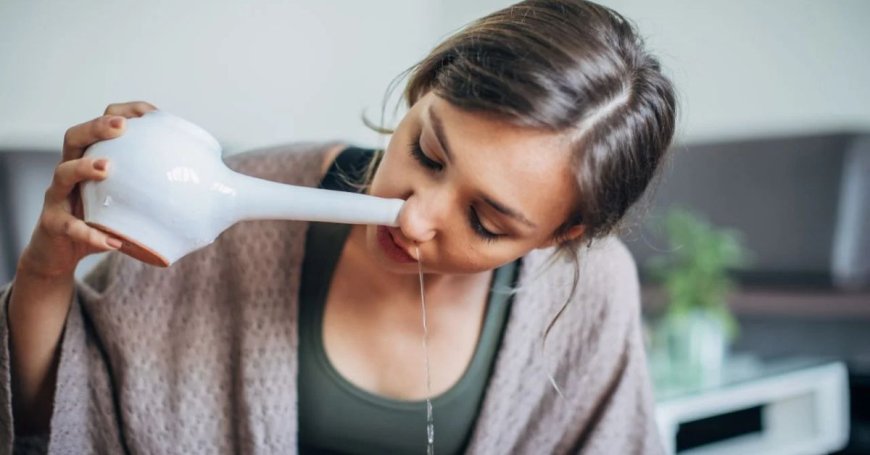Jal Neti Side Effects: What You Need to Know Before Trying Nasal Irrigation
Jal Neti, a traditional yogic cleansing technique involving nasal irrigation with saltwater, is widely practiced for its respiratory and sinus health benefits. While many users report relief from allergies, congestion, and sinus infections, it’s important to be aware of potential Jal Neti side effects. When done incorrectly or without proper hygiene, this practice can lead to nasal irritation, infections, or a disrupted nasal flora. Understanding both the benefits and risks ensures safer and more effective use of Jal Neti.

Jal Neti, an ancient yogic cleansing technique, has been used for centuries as a natural way to maintain nasal hygiene and improve respiratory health. It involves flushing out the nasal passages using a saline water solution, traditionally with the help of a neti pot. This simple yet powerful practice is believed to help clear mucus, reduce allergy symptoms, and even enhance mental clarity. However, while many users experience positive results, it's important to be aware of potential Jal Neti side effects, especially when the technique is performed incorrectly or too frequently.
In this article, well take a closer look at Jal Neti, its benefits, and the various side effects that you should be cautious of before incorporating it into your wellness routine.
What Is Jal Neti?
Jal Neti is part of the six yogic purification methods known as Shatkarma, designed to prepare the body for meditation and higher yogic practices. The term comes from Sanskrit: "jal" means water, and "neti" means cleansing. The practice involves pouring warm saline water through one nostril and allowing it to flow out of the other, thereby cleaning the nasal cavity of dust, pollutants, mucus, and allergens.
Though it's praised for its numerous health benefits, such as preventing sinus infections, improving breathing, and reducing nasal congestion, many people are unaware that improper use of Jal Neti can lead to side effects that may outweigh its benefits.
Common Jal Neti Side Effects
While Jal Neti is generally considered safe when done correctly, several side effects can occur, especially for beginners or those using the technique improperly. Lets explore some of the most common Jal Neti side effects:
1. Burning or Irritation in the Nose
This is one of the most frequently reported Jal Neti side effects. It often results from using an incorrect salt-to-water ratio or using iodized salt. A burning sensation may also occur if the water is too hot or too cold. To minimize irritation, always use non-iodized salt (like sea salt or Himalayan pink salt) and lukewarm, sterile water.
2. Ear Pain or Fullness
Improper posture during Jal Neti can lead to water entering the Eustachian tubes, causing ear discomfort, a feeling of fullness, or even mild pain. This is usually temporary but can be alarming. Ensuring your head is tilted correctly and not blowing your nose too forcefully afterward can help prevent this side effect.
3. Nasal Dryness
Overuse of Jal Neti, especially more than once a day, may lead to excessive dryness of the nasal passages. This can cause irritation, sneezing, or minor bleeding. Applying a few drops of sesame or coconut oil inside the nostrils after performing Jal Neti can help restore moisture and prevent this problem.
4. Dizziness or Lightheadedness
Some users report feeling dizzy or lightheaded after doing Jal Neti, particularly if they have sinus congestion or are new to the practice. This can also happen if you dont breathe calmly during the process or use cold water. Always perform Jal Neti slowly and mindfully.
5. Infections
One of the more serious but avoidable Jal Neti side effects is the risk of infection. This can occur if unclean or non-sterile water is used. In rare cases, using tap water contaminated with bacteria or parasites (such as Naegleria fowleri) has led to severe infections. To avoid this, always use distilled, sterile, or previously boiled and cooled water for the saline solution.
Less Common but Notable Jal Neti Side Effects
Besides the common side effects, there are a few less frequent but noteworthy complications that can arise:
-
Sinus pressure or headaches due to improper technique
-
Prolonged nasal congestion if water isn't completely drained
-
Increased sneezing or coughing shortly after practice
These are usually temporary and may subside as your body adapts to the practice.
Who Should Avoid Jal Neti?
Not everyone is a good candidate for Jal Neti. Certain individuals should avoid this practice or consult a healthcare provider before trying it:
-
People with frequent nosebleeds
-
Those with nasal polyps or a deviated septum
-
Individuals recovering from nasal or sinus surgery
-
Children under 5 (unless supervised by a trained adult)
-
Anyone with an active sinus infection
In such cases, Jal Neti may do more harm than good, and alternative treatments may be more suitable.
How to Reduce the Risk of Jal Neti Side Effects
Here are some tips to practice Jal Neti safely and effectively:
-
Use sterile, distilled, or boiled water only
-
Make a saline solution with to teaspoon of non-iodized salt per 250 ml of water
-
Keep your mouth open and breathe through your mouth during the process
-
Tilt your head properly to allow smooth flow of water
-
Perform Jal Neti in the morning on an empty stomach
-
Dry your nasal passages thoroughly after the practice
-
Avoid doing Jal Neti when you are severely congested or ill
Conclusion
Jal Neti can be a powerful tool for improving respiratory health and maintaining nasal hygiene. However, like any wellness practice, it should be approached with awareness and proper technique. Being informed about potential Jal Neti side effects ensures that you can practice it safely and effectively.
Whether youre a beginner or an experienced practitioner, always prioritize hygiene, proper form, and listen to your body. If any discomfort or symptoms persist, its best to stop the practice and consult a healthcare professional.









































